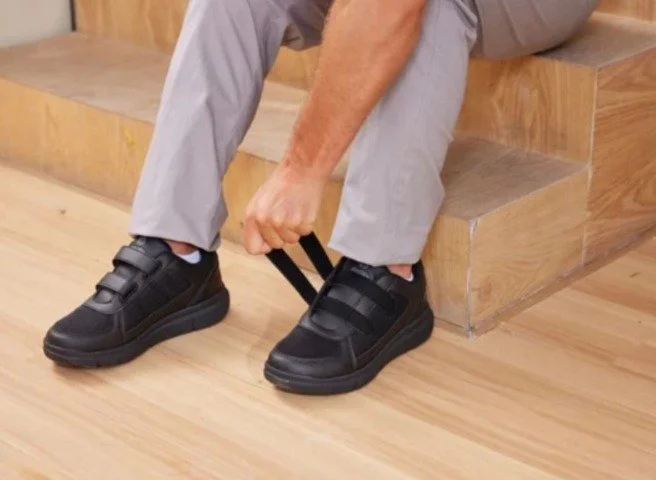Understanding Extra Wide Diabetic Shoes: Features and Benefits
For people with diabetes, taking care of your feet goes beyond just comfort—it's an essential part of managing your overall health. Among the various tools available for supporting diabetic foot health, one of the most valuable, yet often misunderstood, options is the extra wide diabetic shoe. Shoes might look like just another everyday item, but for people with diabetes, they’re crucial in avoiding serious foot issues that could result in infections, ulcers, or even amputations if not taken care of properly.
In this guide, we’ll cover all the essentials about extra wide diabetic shoes. You'll discover why width is important, what sets these shoes apart from regular footwear, and how they safeguard your feet while enhancing the quality of life for those dealing with diabetes.
Why Diabetes Requires Specialized Footwear
Diabetes impacts millions of people around the globe, influencing how the body manages blood sugar levels. As time goes on, high glucose levels can harm nerves and blood vessels all over the body, and the feet tend to be one of the most affected spots.
One of the most frequent issues that comes with diabetes is peripheral neuropathy. This condition affects the nerves in the feet, causing symptoms like numbness, tingling, burning sensations, or even a complete loss of feeling. If someone has reduced sensation, they might not notice small cuts, blisters, or pressure points. This can lead to injuries getting worse over time without them even being aware of it.
At the same time, diabetes can affect circulation, which in turn slows down the body’s natural healing process. When blood flow is reduced, it can slow down the healing of wounds and raise the chances of infection. All these factors increase the chances of serious complications that can get worse quickly if we don't take preventive measures.
Diabetic footwear is really important here. Wearing the right shoes can really reduce the likelihood of getting sores, blisters, or ulcers from the start. Diabetic shoes are designed to minimize pressure points, enhance circulation, and avoid friction, all while providing the necessary support and comfort for everyday activities.
The Need for Extra Width: A Common Requirement in Diabetic Foot Care
Diabetic shoes have a lot of important features, but for many patients, the width is one of the most crucial aspects. Diabetes can lead to swelling, changes in foot structure, and deformities like hammertoes or bunions, which means that regular-width shoes might not be enough.
Swelling, or edema, can cause your feet to change size, often getting bigger as the day goes on. Traditional shoes that feel comfy in the morning can turn painfully tight by the afternoon, pinching circulation and causing those annoying pressure spots. Extra wide diabetic shoes are designed to fit these needs, offering ample room for natural expansion while still providing the necessary support.
Structural changes like bunions, hammertoes, or flat feet can lead to uneven pressure distribution, which means you might need extra width and depth. If there's not enough space, your toes might get squished together, which can raise the chances of developing ulcers on those bony areas. These shoes provide extra width, which helps avoid localized pressure that can cause skin breakdown and serious infections.
For diabetics who don’t have major foot issues, choosing extra wide options can really help. They make sure the foot isn’t cramped or squeezed, creating a safer and more comfortable space for those sensitive feet.
What Makes Extra Wide Diabetic Shoes Different from Regular Shoes?
At first glance, extra wide diabetic shoes might look like regular shoes, but they actually have some special features designed to tackle the unique challenges that people with diabetes face. Every design element plays a role in keeping your feet healthy.
The depth of the shoe is one of the most noticeable differences. The extra depth provides space for custom orthotics, swelling, or foot deformities, ensuring that there's no added pressure on the upper part of the foot or toes. This extra internal space makes sure that even when your feet change during the day, they stay well-supported and comfortably snug.
The toe box is an important part of the design. Extra wide diabetic shoes feature a toe box that’s not just wider but also higher, allowing your toes to spread out comfortably. This helps avoid friction against the sides or top of the shoe, which lowers the chances of getting blisters, calluses, and sores on sensitive spots.
Having seamless interior construction is super important for safety. Regular shoes can have internal seams that might irritate sensitive diabetic skin, leading to abrasions or sores. Extra wide diabetic shoes have smooth interiors, usually lined with soft, padded materials to reduce irritation and friction.
Also, the outsoles are made to absorb shock and lessen pressure on your foot. Walking can put a lot of repetitive pressure on diabetic feet, which might lead to strain. Extra cushioning spreads out the weight nicely, which helps lessen stress on those trouble spots.
We also take a close look at closure systems. Lots of extra wide diabetic shoes come with adjustable closures like Velcro straps or elastic lacing. This means you can get a fit that changes with daily swelling, and they’re super easy to secure without putting extra strain on your hands or fingers.
The Protective Role of Extra Wide Diabetic Shoes
Diabetic shoes, particularly those in extra wide sizes, are mainly designed for prevention. Diabetic footwear stands out from regular shoes because it focuses on more than just looks. It's specifically made to help lower the risks linked to nerve damage, poor circulation, and a higher chance of infections.
These shoes really help cut down on friction, pressure, and constriction, making it much less likely for you to get blisters, corns, or open wounds. They help with even weight distribution, which can stop stress points from forming that might cause skin issues.
Another key role is keeping the temperature in check. Lots of diabetic shoes use breathable materials to manage moisture and heat, which are important because they can lead to fungal infections or skin issues. Ventilated shoes help keep your feet drier and cooler, making for a healthier overall experience.
If there are already wounds or ulcers, doctors might recommend extra wide diabetic shoes to help with the healing process. These shoes help relieve pressure from the areas that need it, giving damaged tissues a chance to heal while letting the person stay mobile and independent.
How Proper Footwear Supports Long-Term Diabetes Management
Extra wide diabetic shoes offer more than just immediate comfort; they come with a range of benefits. As time goes on, they play a significant role in helping a patient stay active, mobile, and independent—key elements in successfully managing diabetes.
Being physically active is really important for keeping blood sugar levels in check, staying at a healthy weight, and boosting heart health. But when foot pain or complications aren't managed, it can really hold diabetics back from getting into a regular exercise routine. When shoes help ease discomfort and avoid injuries, patients tend to stay active, which creates a positive cycle that boosts overall health.
Also, properly fitting diabetic shoes can help lower the need for foot-related treatments. Stopping ulcers can lead to fewer trips to the hospital, less need for wound care, and a reduced chance of infections that might turn into serious complications. In a lot of situations, wearing the right shoes can really help patients steer clear of amputations, which is a serious but avoidable result linked to uncontrolled diabetic foot ulcers.
Extra wide diabetic shoes can really help aging adults with diabetes by improving their balance and stability, which in turn lowers the chances of falls and fractures. Having good traction, solid ankle support, and a proper fit really helps ensure secure footing, even when neuropathy impacts sensation.
Who Should Consider Extra Wide Diabetic Shoes?
Extra wide diabetic shoes are great for people with diabetes who deal with foot swelling, deformities, or neuropathy. However, they can also be beneficial for anyone facing foot-related issues.
People dealing with chronic edema, arthritis, neuropathic pain, or circulatory issues often find that the protective design of these shoes really helps them out. Older adults might discover that extra wide diabetic shoes are great for addressing foot changes that come with age, all while offering better stability and comfort.
For diabetics who have healthy feet, wearing extra wide diabetic shoes can be a smart move. It helps prevent issues before they become serious complications. Doctors, podiatrists, and certified pedorthists usually suggest getting specialized footwear early on to keep your feet healthy for the long haul.
Getting Professionally Fitted for Extra Wide Diabetic Shoes
Since everyone's feet are different, it's really important to get the right fit when choosing diabetic shoes. When you visit a podiatrist or a certified shoe fitter, they can measure your feet accurately in both length and width. They'll also check your arch type, pressure points, and how you walk.
Custom orthotics might be suggested alongside diabetic shoes to offer extra support, balance, and pressure relief that’s tailored to individual needs. Lots of extra wide diabetic shoes are made to fit these inserts comfortably, ensuring there's no sacrifice in space or fit inside.
Patients can look forward to regular check-ins, since foot shape and sensitivity might shift over time because of disease progression, weight changes, or other health-related factors. Regular check-ins help make sure that footwear continues to meet changing needs.
The Psychological Benefits of Proper Diabetic Footwear
Besides the obvious medical benefits, wearing comfortable and well-fitting diabetic shoes can also boost your mental well-being. Living with chronic foot pain, wounds, or limited mobility can really take a toll on your quality of life, impacting your mental health and emotional well-being.
When patients feel comfortable and backed by their footwear, they get their confidence back to take part in daily activities, hang out with friends, and enjoy their hobbies. Being able to walk comfortably without worrying about getting hurt really helps people feel more independent and in control of their situation.
Even simple things like grocery shopping, hanging out outside, or catching up with friends feel a lot easier and more fun when you know your feet are well-protected. As time goes on, these little improvements really add up, leading to a greater sense of satisfaction in life and stronger emotional resilience.
A Small Investment That Yields Lifelong Protection
For people dealing with diabetes, extra wide diabetic shoes are much more than just another pair of shoes. They play a crucial role in a complete foot care plan that helps guard against some of the most serious and preventable complications linked to the disease.
These specialized shoes tackle the unique challenges of swelling, deformities, and neuropathy, making it safer for vulnerable feet. They also boost comfort, mobility, and overall quality of life. Extra wide diabetic shoes offer significant advantages, whether they're prescribed to prevent issues or used in ongoing care after complications occur. They provide benefits that go well beyond just being a basic pair of shoes.
In a lot of situations, being proactive with the right shoes can really help maintain mobility, independence, and sometimes even save a life. If you’re living with diabetes, getting specialized shoes designed for your specific needs is a smart and practical way to help maintain your long-term health.





